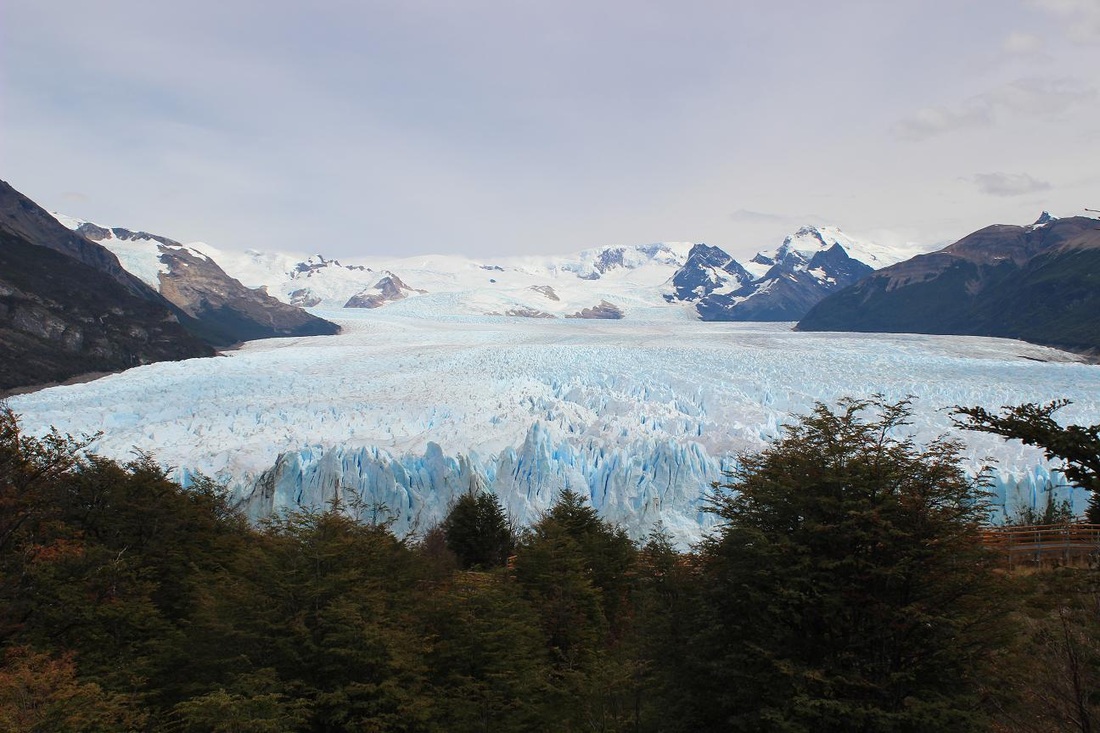
The cold hard facts: 5km wide along its face, 30km long, 170 meters total depth (average 75m above water). One of the few advancing/stable glaciers remaining.An amazing sight to behold!
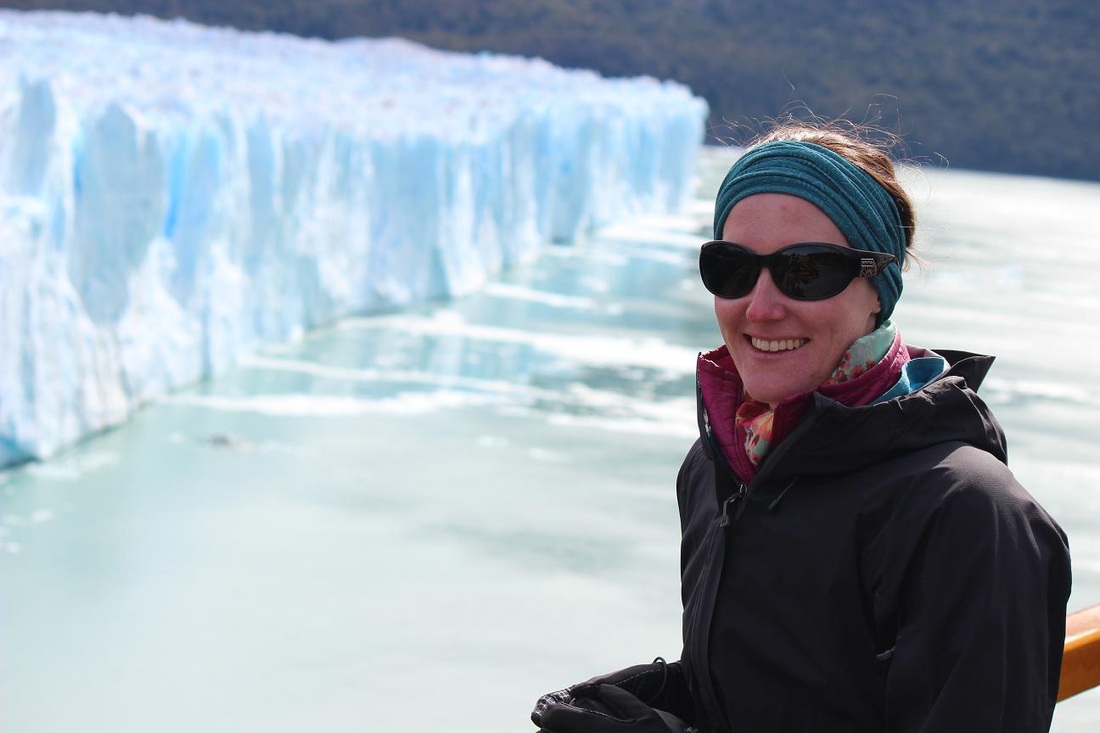
Still smiling after 6 hours watching the ice!
|
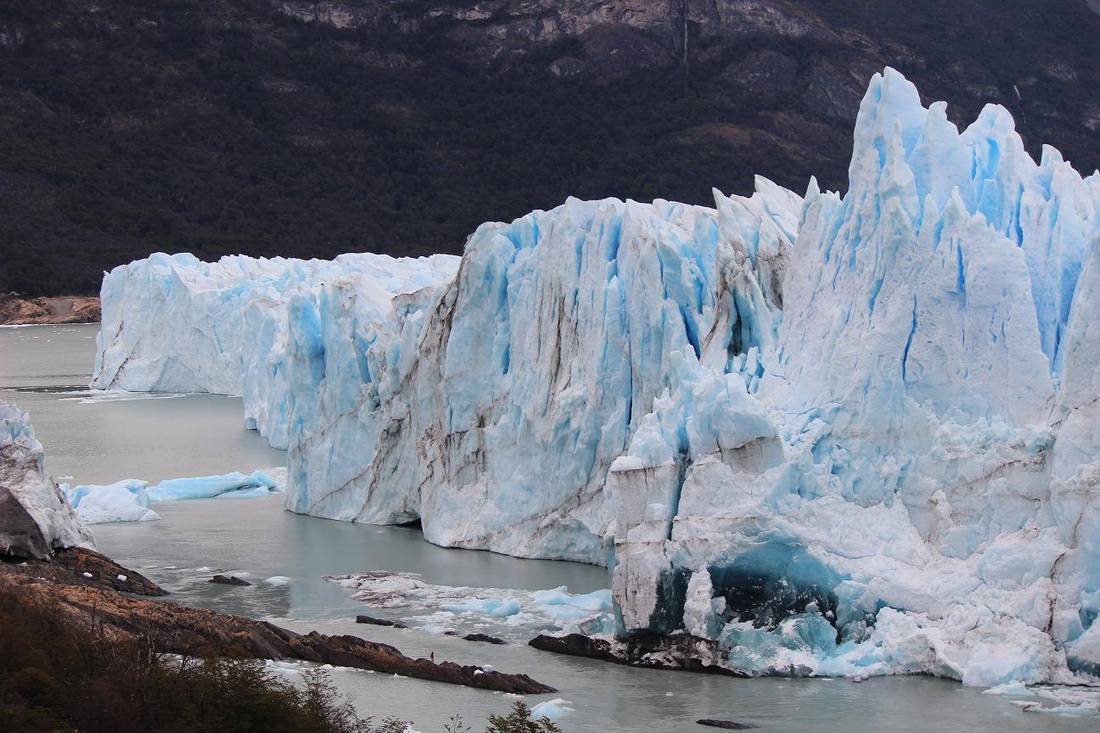
To help give you a bit of perspective on the immensity of this glacier, if you look closely you will see a person standing on the rocks in front of the glacier.
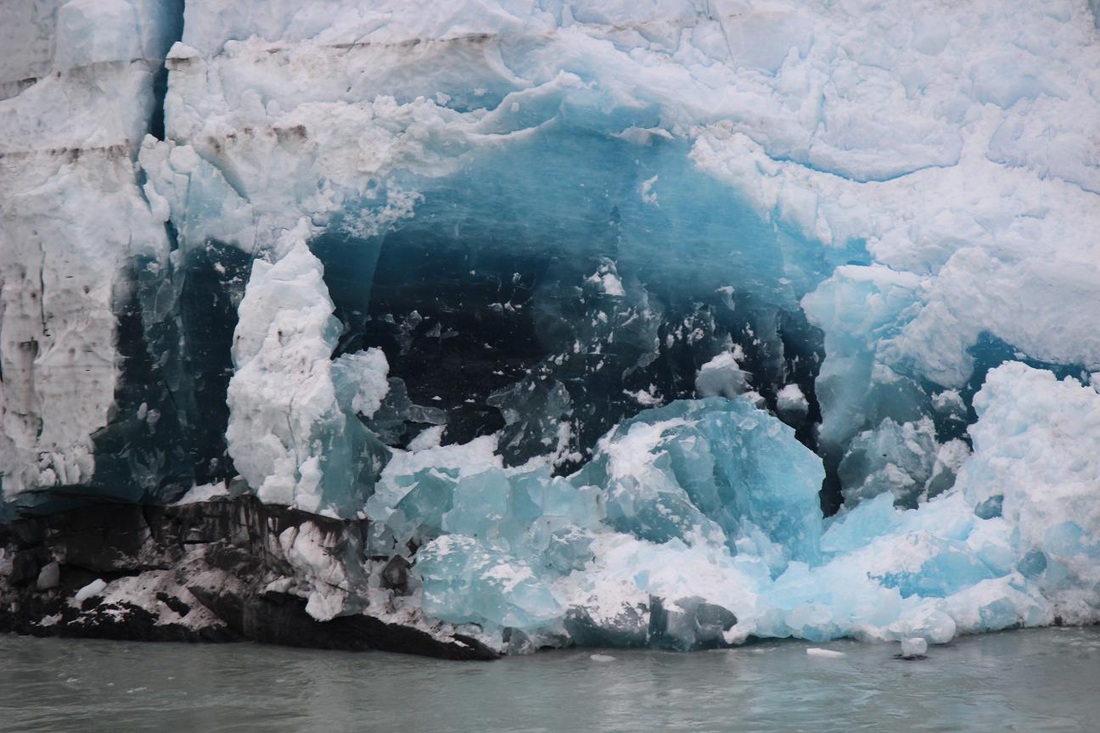
The darker the blue, the more compressed the ice. This is some dense ice!
| There is really nothing we can say to describe this amazing glacier. We hope our pictures helped to convey some small glimpse of how enchanting it is to watch glaciation in progress.
We spent a rainy 2 nights in Caleta Tortel, a town set in Jurassic Parkesque scenery, immense cliff faces, rainforests, and of course glaciers. In addition to the immense scenery the town is set along a fijord and is built on stilts and boardwalks. In order to get around town we had to navigate the maze of boardwalks along the water and stairs through the hillside, it was a unique experience. We had a bit of trouble getting out of town, but once at the fork in the road it took only 4 minutes to get our next ride. A father and son duo from Valpariso picked us up. They were on a 3 month road trip for the son to see the amazing landscape that his country contains and for the father to collect seeds of all the different native plants. Arriving in Villa O’Higgins we were only mildly surprised to learn of the upcoming rodeo! So our day was spent watching the wauchos (cowboys) perform with glacier covered mountains as a backdrop. Our evening spent drinking pisco and Coke and dancing to the live band in the gymnasium of the school, much to the entertainment of ourselves and the locals I am sure. It was a perfect way to round out our time on the Carretera Austral.
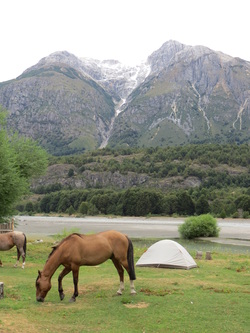 An interesting quirk arising from the remoteness that we sought and found on the Carretera Austral; few banks & few ATMs, even fewer that would accept VISA. Having not accounted for this prior to embarking, we found ourselves low on cash and hence hitching the next 300-odd kilometers. So early on the rainy Monday after the festival we could be found on the only road out of town with our thumbs stuck out. After maybe two hours we struck gold! And to boot it was in the cab of a truck, better than out in the back with the dog in the rain – luxury! It came to pass that our ride, Nelson, had a campsite on his estancia abut halfway to our destination. A quick check of the schedule – open – and we had arrived at our home for the night. The estancia had been in his wife’s family for three generations and her great-grandparents were the original settlers on that land. They were situated on the Nadis Rio surrounded by glacier-coated peaks. The crazy thing is that after all the amazing vistas we had seen we found this place pleasant, but not breathtaking – boy we are spoiled!
 The original homestead During our stay we were fortunate to gain a unique insight into the resourcefulness of the locals that lends itself to their resilience in a harsh environment. As they had just slaughtered two lambs for an Asado (BBQ) that evening we were able to witness them utilizing every part of the animal; the sheep-skin drying in the shed, the heart, lungs, etc smoking over the fire and the rest roasting and dripping its fat and amazing smell of campfire and roasting meat. The pioneering spirit is very much alive here. And I have to admit it has been difficult at times but I have really gained a much deeper knowledge and respect for how and where the meat I eat comes from. We immensely enjoyed the corderro (lamb) that Nelson and Marisol shared with us, amazing Chilean hospitality. The following day we journeyed through adjacent estancias to see the confluence of the Baker and Nadis rivers. Bek spend a bit of time practicing her Spanish with their 15 year old daughter who industriously spends her free time making jewelry and knitted goods. Additionally Bek bought a headband the daughter had made using wool they had spun from their own sheep and dyed with the berries from the Calafate bushes on their property. Talk about getting back to the land, they had one solar panel that generated their electricity, their water was from the stream that ran through their yard and their food came from their kitchen garden and their cattle. In the winter Marisol and their daughter move up to town so the daughter can go to school and Nelson spends the long winter days alone at the Enstancia. Three hours of sunshine a day and the rest darkness and snow, I am truly humbled by the fortitude, industriousness and resourcefulness of the people who live in such an intense and remote part of the world.
After four plus hours of unsuccessful hitch-hiking in Rio Tranquilo we threw in the thumb and hopped the only bus that day down to Cochrane. We treated ourselves to a couple of luxurious nights in a real bed before heading to the hills for a three day trek. Reserva Nacional Tamango contains the largest population of Humules (Andean Deer) in the world. Despite their endangered status we had high hopes for a sighting due to the relatively small size of the reserve. As our luck would have it we did not encounter a single deer during the trip; although we did manage to see a Mink which had caught a fish! We were quite excited until we learned that they are a pest, having escaped from a fur farm decades ago and not doing much to help the Patagonian fauna. Not many people out trekking in the reserve – the guardiaparque actually gave us quite a tough time about going out trekking. As it turns out they were currently searching for a missing hiker. They only found him two days later! We did meet two University students from Conception who were living in the reserve for a month as part of there studies. Their job was to go out trekking each day to search for Huemules. Their colleague had spent January in the reserve and only seen seven. They had been there five days and not only had already seen nine, but also rescued the lost hombre. Pretty good start :) During our three very hot and very dusty days we did manage to enjoy ourselves, despite the lack of wildlife, in large part thanks to icy dips in the lake and reveling in the isolation.
We returned to town in time for the rodeo. Lots of stalls with food and craft and activities such as kids trying to ride sheep and catch greased piglets, men riding calves which had just been branded and a ‘traditional’ game that looked suspiciously like hop-scotch. All-around great fun! Less enjoyable was the conditions in the campground. There was only one campground in town and everyone was there. Twenty-seven tents on top of each other, two showers with limited operating hours, and one toilet, seat not included!!!! Needless to say we got out of there pretty fast.
| Life on the Chilean rodeo circuit is no picnic; rough and tumble; a never-ending grind of dust and dedication, ponchos and leather boots following the tour as it winds its way south, donde el diable perdio su poncho. How have we come by this dear understanding of such an event? In the five weekends that we have spent on the Carretera Austral we have found ourselves spectators at four rodeos! Our first was in Futaleufu as previously mentioned. Following this we caught the show at Puerto Rio Tranquilo. This tiny town is located beside the gorgeous and insanely turquoise Lago General Carrera. We thoroughly enjoyed both the rodeo itself and the stunning (studding…???) view from the pride of the town, the recently (cow)-pleted media-luna (stadium). Additionally we took the time to visit the Marble Caves. This collection of caves & arches located on the shores of Lago General Carrera are created from the marble cliffs’ erosion due to wind and waves. The combination of the white marble, blue water and sunshine makes these caves a magical sight. Later we visited Valle Exploradores to view the glacier of the same name. The road wound though pristine forest alongside a ridiculously beautiful river with small tranquil lakes. Our only company was the occasional grazing cow. We hiked 20 minutes up a hillside to be greeted with an amazing view of a glacier almost directly below us. We could see the glacier winding its way down a valley and around a curve to deposit its till where we stood. Everywhere was evidence of glaciation, with mounds of soil and massive boulders being transported by the ice, all in a day’s work for a glacier busy creating a new valley. We have seen many glaciers to date but this was a unique view for us and really helped us to appreciate the process of glaciation.
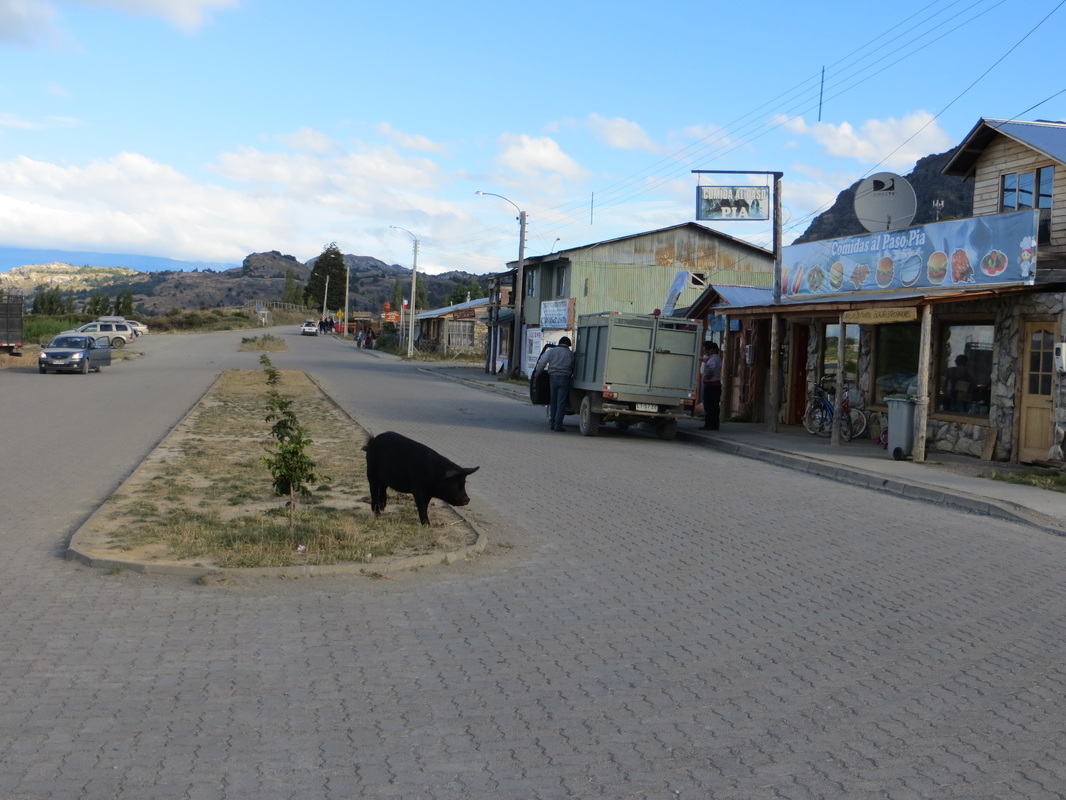
Yes that is a pig, and yes this is the main drag of the town of Puerto Rio Tranquilo. Life moves at a much slower pace here and we love it.
| |
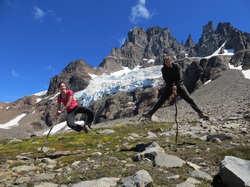 Bek’s favorite place to date! It took us a full day of hitching just to get to the trail head from whence we could start the five day trek. From Coyhaique we needed five rides, two from Coyhaique to Villa Cerro Castillo (100km) where we dumped some of our excess baggage and a further three rides to get back 25km to where the trek started. A bit of a complicated day, but we got there in the end – thanks to all the people who picked up two random hitch-hikers.
The first 2 days were mostly trekking through an estancia (ranch) to actually reach the national park. We encountered only 3 people those first 3 days. The first was a park ranger who had spent 3 years in the US working on ranches in Fresno CA, Colorado, and Wyoming. The other two were hikers doing the trek in the opposite direction; they were also accompanied by a cute little dog. This dog allegedly followed a cyclist from Ushuaia all the way up to Cerro Castillo and the cyclist had somewhat adopted him and gave him a bandana and fed him. When these trekkers met the cyclist, the dog decided to join them instead and ditched the cyclist. Unfortunately the dog then decided to join us. Up and over the same steep & snowy pass and down a dodgy (doggy?) descent that it had just completed. It was a long day for us, longer for pooch!
The following day the dog stuck with us for an hour or two, then ditched us!!!! Kinda floored us after the hospitality that we had extended to it. Fed him from our meager rations, let him sleep under the fly of our tent, cleaned the burrs from his fur, and then he ditched us? The third day of the hike was the most magnificent. We spent the day trekking in the shadow of ragged peaks cloaked in glaciers. There were at least 4 different glaciers we saw that day; each one precariously perched on to the sides of these intimidating peaks. Waterfalls gushing & forming gorgeous lakes and ponds. The main peak, Cerro Castillo had a huge hanging glacier and protected an intense blue-green lake. It was magnificent. From the lake we hiked up the opposing mountainside to enjoy a wonderful view of Cerro Castillo and its lake and glaciers, and the river valley on the other side. Words can’t describe the solitude and beauty of this place. We had a very steep descent through loose rocks then down a very very dusty path to the river and our next campsite. Two more days of trekking brought us back to Villa Cerro Castillo and some very welcome and much needed hot showers. It was with quite a bit of reluctance that we left this beautiful locale behind us. It was only the promise of future adventures that lured us forward. Otherwise we may have done the entire trek over!!
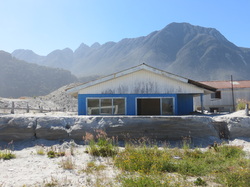 We had no idea of what to expect for our journey on the Carretera, a 1200km mostly gravel road through Chile's deep south, but so far we have been well impressed. The road itself took some 15 years to complete during General Pinochet's reign in the '60s and '70s. We arrived in the early hours one foggy morning after an extremely uncomfortable night on the ferry to the town of Chaiten. It was hours before any shops were to open so we entertained ourselves by sitting on the waterfront watching people disperse through town, only to return 15 minutes later to wait for the town to wake up. Chaiten is half ghost town, half sleepy fishing village. In 2008 a bump in the earth 5 miles north of town that no one had given much regard to commanded respect with a month long eruption of ash and a pyroclastic flow that scorched the western hillside! The town was partially destroyed by flooding and ash from this eruption. Many people have returned to thier homes to resume life as best they can, but as the town has been officially closed there are no services such as the hospital, school and other infrastructure. We saw one portion of the town that was still buried in over 4 feet of ash. Interesting to say the least.
Next on the agenda was a visit to Doug Tompkins (think North Face & Espirit) very own private park, Parque Pumulin. During the three days of camping we went on a number of enjoyable hikes - through rainforest up to waterfalls and lakes. It was quite hot but we were able to cool down with cool dips into the crystal clear water. The highlight of that trip was when we saw 4 baby owls on the side of the trail. They were just as interested in us as we were in them and each time we moved to get a better camera angle they cocked and bobbed their heads to make sure they could catch everything we were doing.
Our next stop was Futaleufu, home to one of the top white water rivers in the world. Totally by chance we happened to be there on rodeo weekend and saw the cowboys strutting their stuff in traditional garb. A few days spent lounging by the river and taking some short hikes and we were amped up for our trip on the Fu. It was a fantastic trip on the water. We have each been rafting a few places before but we have never encountered waves so big, or so many rapids in quick succession. It was absolutely fantastic! We may have to return one day to spend more time on the river, I could run the same section of the river 5 times and still find it exciting.
Destination number three, National Park Queulat. Home to a huge hanging glacier as well as a beautiful blue lake filled with icebergs! We camped for 2 days and were serenaded to bed each night by a talkative fox. It was also a place of reunions. We bumped into a couple we had camped with in Pumalin who are biking the length of the carretera as well as the couple we shared our Futaleufu rafting experience with. This park also reminded us of the extreme generosity of people. One day while hitching to a trailhead we had a car roar past us, only to return a few minutes later to see where we were headed. Fifteen minutes down the road and he was offering to drive us to his home town to host us for the weekend while a festival was on. Another family who had offered us a ride the day before gave us a ride back from the trail to our tent even though it was out of thier way. And our rafting friends let us ride with them the 4 dusty hours to our next destination.
The Carretera Austral, althoug mostly dirt/gravel, is much nicer than we expected. We even hit the pavement for a spell on the way into town tonight. The vistas are absolutely stunning. The road winds its way along a river valley between two sets of parallel mountains. The mountains, or more realistically big hills, are covered in rainforest -quite unexpected a this southerly latitude- and topped by glaciers! The rivers are extremely clear but with a nice-icey blue hue. It is beyond beautiful and we are so grateful to be able to experience this part of the world.
We are now in the metropolis hub of the south, Coyhaique, boasting some 50,000 people. Although it may sound small to most of you it feels huge to us at the moment. There are two, yes two, big grocery stores that actually have fruit and veg! Up to now most of the towns have had a few corner stores for our grocery needs; it is quite easy to find beer, wine, soda, cookies and pasta or other dehydrated foods, but anything fresh is difficult to come by. It has really opened our eyes to have fortunate we are in the US and Australia to have the quality and selection of food available to us that we usually take for granted.
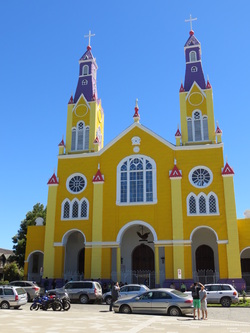 We were drawn to Chiloe as we had heard that it had a uniqueness quite unlike anything on the mainland despite the close proximity of the island. The inhabitants of Chiloe maintain a distinct culture with a unique belief system as well as comida. We were able to experience curanto al hoyo - a meal prepared by cooking chicken, pork, potatoes and shellfish in the ground on hot stones covered by palm leaves and soil. While Dale was in heaven eating all that shellfish, Bek put on a brave face and suffered through it, and unfortunately continued to suffer for 3 days afterward with food posioning (it is not all kittens and sunshine on the tourist trail :). At least we held a mutual interest in Chiloe's religious beliefs.
The natives had/have a history of mythology: witches, gnomes, ghosts and pirates are all alive on this island. And the Jesuits who came to Chiloe to convert the inhabitants many centuries yonder decided to minister to them by melding together the Christian beliefs with those of the natives. Hence the churches have many interesting quirks such as paintings of Jesus surrounded by these mytholigical creatures, and a wood carving of a Saint defeating Satan, in the form of a goblin. Quite unexpected. The churches themselves were quite beautiful as well, some built as early as1740 and others as late as 1912 Some were quite plain on the outside, just weathered wooden shingles, but absolutely stunning on the inside - amazing hand carved woodwork. While still others were bright and engaging on the outside yet plain and simply functional on the inside. And the largest church, in Chiloe's capital city ofCastro, was amazing on the outside and in; gothic in style but created completely out of wood. It was a very tranquilo ten days we spent on the island but by the end we were ready for our next adventure.
| We had a bit of a rocky start to our time in Chile, we had our plans all set and an agenda laid out when we found out that the immigration building at the border crossing between Argentina and Chile had burnt down! So with a slight reshuffling of our plans our 4 hour bus ride became a 12 hour bus ride and we arrived in Puerto Montt, Chile. The upside was that it turned out to be 12-hrs driving through spectacular mountain ranges and farm land punctuated by immense snow-capped volcanoes.
After dropping our luggage we went to get some food at the bar recommended to us by Perla, the Grandma-esque lady at whose house we were staying. Well that was a great idea, we walked into the bar and all conversation stopped as people gazed at us over their beers. Everyone appeared to be just finishing a hard days work and were enjoying their beer and cigarettes. As unemployed travelling loafers we clearly did not belong. It has been a long time since I was in a bar or restaurant that allowed smoking, can´t say that I miss it. We ordered the pichanga for 2, another great idea. It was an immense pile of french fries covered in steak, sausage, pickles, avocado, egg, tomato, olives and pickled carrot and it was delicious!! Turns out it roughly translates in spanish as `party`.
The next day found us on a ferry to the island of Chiloe. We spent the next 2 days watching the deluge from inside the comfort of a particularly nice hostel, lunas13. Run by a couple of enterprising & amiable young men. while. It cleared up long enough for us to hop into a car and navigate the dusty backroads to a festival in the back of some guy´s farm. There we had some fun with the language barrier and making bad assumptions, ordering dozens of empanadas when we though we were only ordering a few. A glass of wine also turned into a bottle (and at only $5 a problem I would not mind repeating). We were invited out back to share in some homemade apple cider and watch as they made chochoca. Still not entirely sure what it is but it involved a lot of pork fat and after it was grilled was filled with pork. A bit bland but an experience none the less.
After a few days in Ancud we made our way to the out-of-the-way ´town´of Chepu, if you count a town as a few houses along a road. We camped at an Eco-lodge and took advantage of the excursions on offer. Day 1 a six-hour return boat ride/hike to see the penguins. Unfortunately we did not see any penguins, but we were rewarded with an encounter with a pudu, the world´s smallest deer. They are quite shy but we were lucky to see two pudu on two different occasions. After watching all of those episodes of Planet Earth I felt like I was actually experiencing some of the stuff I had been dreaming about for so long.
Day 2 a sunrise kayak on the river. What I failed to mention before is what makes Chepu extremely interesting is that after a huge earthquake in 1960 a large portion of the forested land actually sunk a couple of meters. This altered the landscape enough to allow salt water to rush into the land and killed thousands of trees. This sunken land is therefore strewn with the remnants of this forest and is quite amazing. The eco-lodge overlooks this remarkable scene.
So we were up at 4:30am to get out on the river. We had a rare rainless morning and were able to watch the sun rise over the water. Just as the sun had finished its brilliant display we saw a creature swimming nearby in the water. Completely unconcerned by our presence a Coypu, or an extremely large water rat close to 20lbs!, came up onto the land 5 feet from us and began chomping on some grass. We sat for close to 5 mintes as he foraged around hobbling together a breakfast feast. We, though this term can only be applied very conseratively because Dale still has his arm in a cast, paddled upriver for another hour or so admiring the scenery, dodging tree stumps and spotting all sorts of different birds. It was a unique experience to be on the water in a sunken forest, especially before dawn when the logs took on all sorts of mystical shapes.
| |
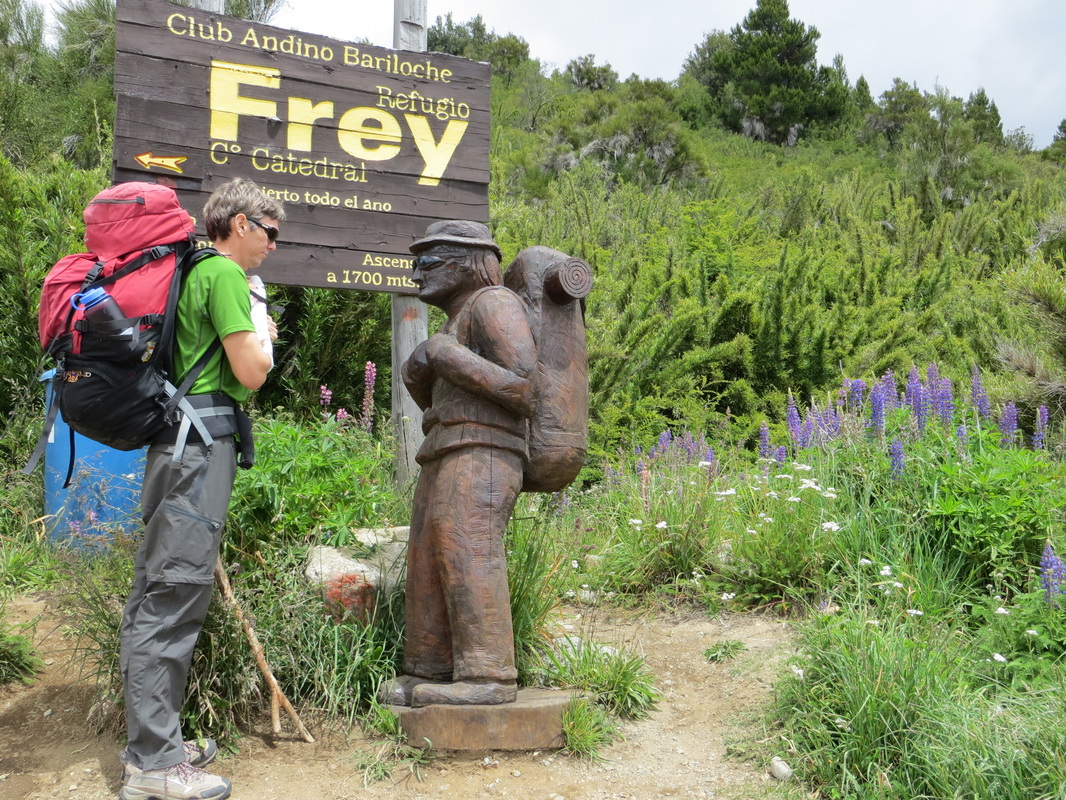
He eventually won the stare-down, it was a hard-fought victory.
At the trail head for a 3-night trek that would welcome in our New Year.
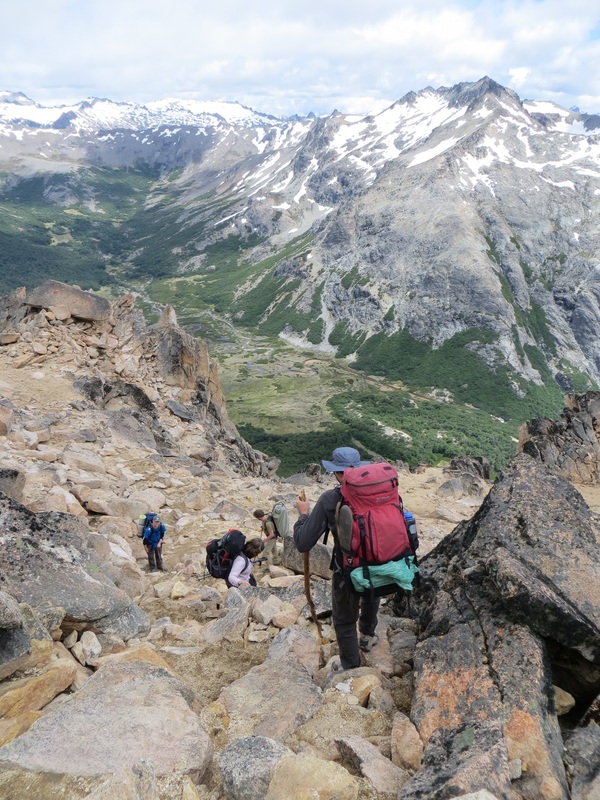
Yikes!!!
Descent One.

Delerously happy after finishing the box of wine that Dale has been carrying for 2 days.
The sun sets on the lake at Refugio Jakob & 2012.
|
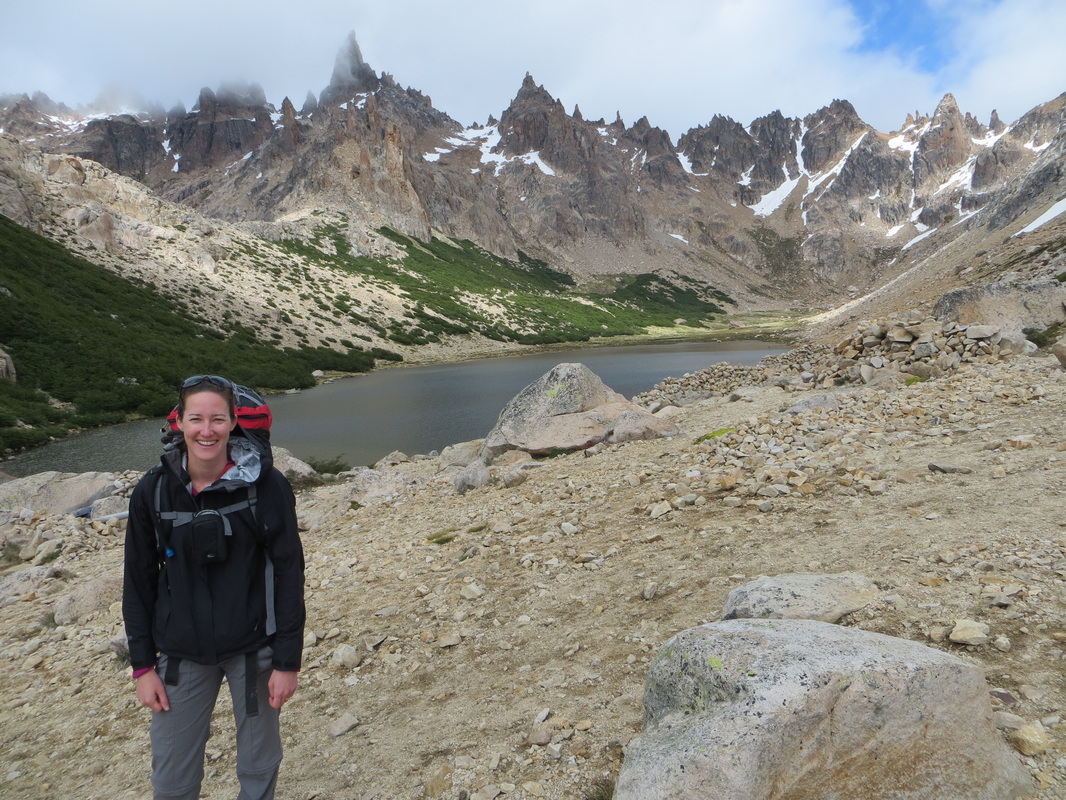
Bek`s smile of satisfaction could easily be mistaken for delerium after slogging up the slope and finally reaching Refugio Frey campsite.
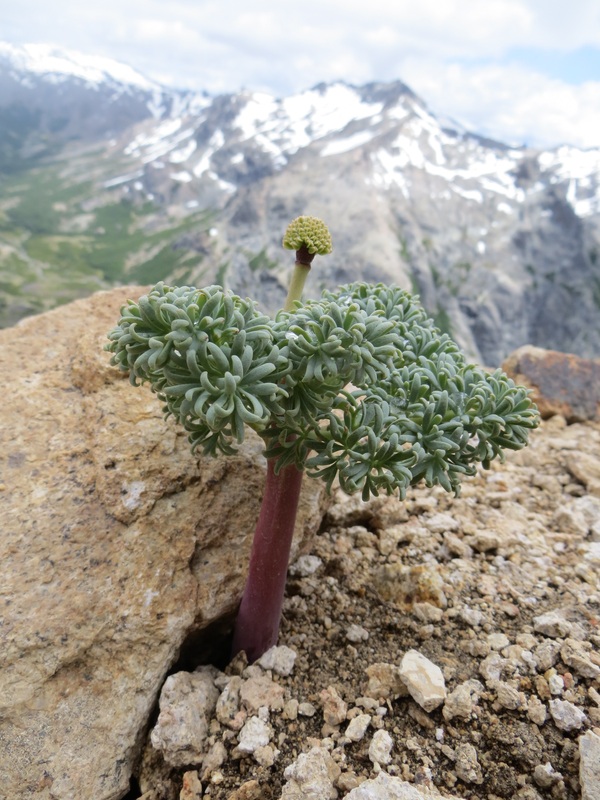
Bonza Bonsai.

A traditional parrilla BBQ at a very untraditional location for Bek & Dale`s NYE. Lamb dinner at Refugio Jakob.
|

Bek is no longer capable of disguising said delerium as we scale our first of two ascents the following day. Cruelty is the hike that sends one up and down and up and down only to finish 50 meters in elevation from the starting point, 8km and 6 hrs later.
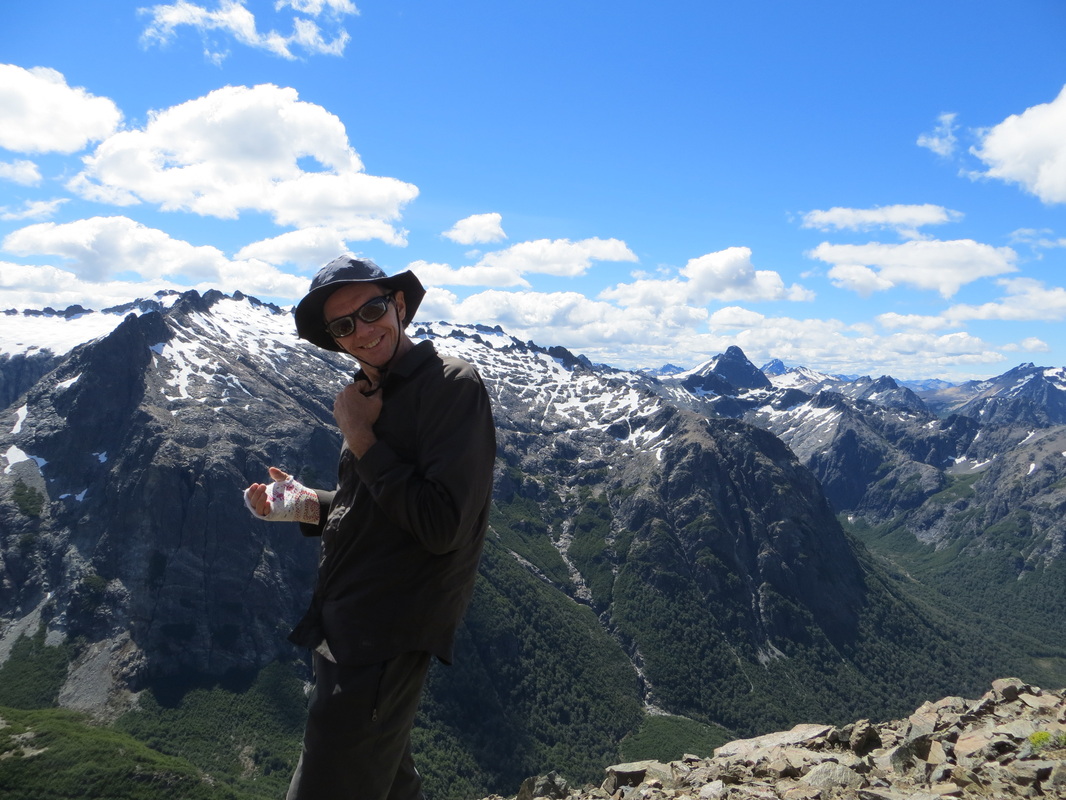
Dale drops the pack to allow his spine time to unwind.
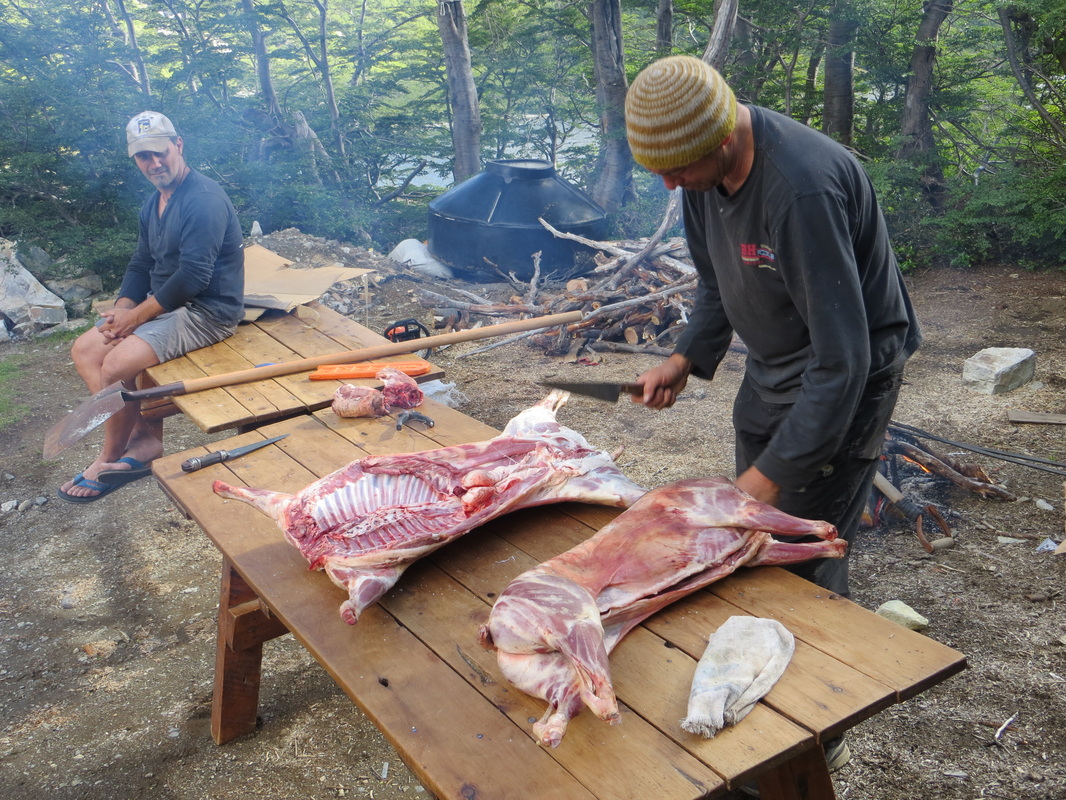
Argentinian kitchen. Man with knife also served us dinner with same bare hands on same bare table...
|
|